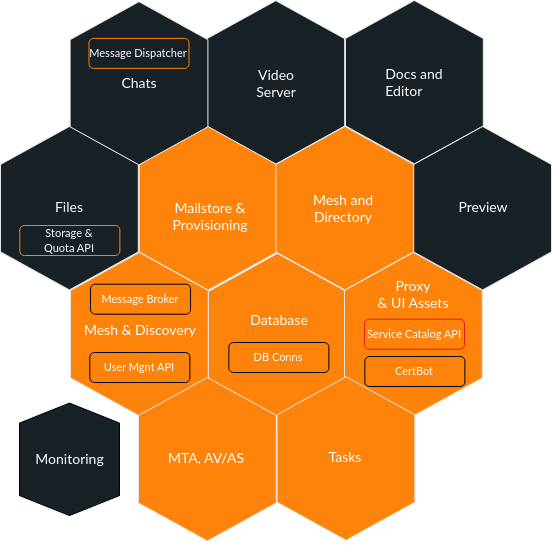Architecture of Carbonio CE#
This section contains a description of Carbonio CE architecture and of the Components along with the features they provide.

Fig. 1 Simplified architecture of Carbonio CE.#
Fundamental Concepts#
Carbonio CE is built on a multi-component architecture. Each component is responsible for a specific part of the collaboration suite and can be installed on a Single Node or distributed across multiple Nodes.
Core and Collaboration Components#
Within the collection of Components, we can distinguish:
Core Components
These are required for the basic operation of Carbonio CE:
MTA / AV-AS: Sending and receiving emails
Mailstore and Provisioning: Account provisioning and message storage
Proxy: Web access
Database / Mesh and Directory: Backend services required for infrastructure operation
Collaboration Components
These add advanced collaboration and communication features to Carbonio CE:
Files
Chats
Docs and Editor
Tasks
Preview
Video Server
Additional Components and Monitoring
Monitoring: Centralising metrics with dashboards tailored for Carbonio CE
Component Communication#
All components communicate over Carbonio Mesh, a secure internal service layer that provides:
Service discovery
Automatic configuration propagation
Secure RPC over HTTP/HTTPS
External clients (webmail, mobile apps, third-party clients) typically interact through the Proxy node which routes the traffic to internal services.
Accessing Carbonio CE Services#
Once the installation is completed, Carbonio CE features are available via:
The main webmail interface, see Section Access to the Web Interface
Carbonio CE mobile apps (Mail, Files, and Chats)
Third-party clients
Supported protocols include:
POP3 and POP3S
SMTP and SMTPS (SMTP over TLS/SSL)
IMAP and IMAPS (IMAP over SSL)